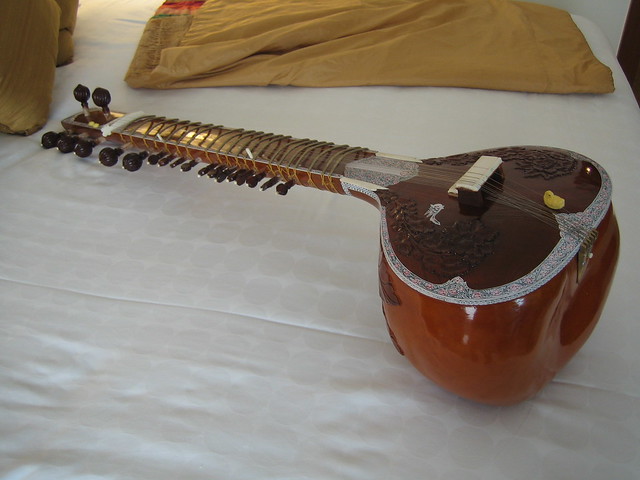 |
| SITAR RAVI SHANKAR STYLE AT-www.sathyadeepmusicals.com (Photo credit: Wikipedia) |
Legend says that the sitar was invented by Amir Khusro himself an Indian poet, scholar, and musician.
Mainly used in Hindustani classical music, the sitar has been around for over 700 years. Made with a gourd body (often carved out of a pumpkin), the sitar comprises of the basic elements of a stringed instrument. It has a neck, pegs, strings and a body. A sitar can have 18/19 or 20 strings, it also has 11, 12 or 13 sympathetic strings of which 3 or 4 provide the drone and these are located underneath the frets.
Up until the 1960s, the sitar had never been used in popular music. George Harrison was to change all that.
During a break filming Help, Harrison picked up a sitar (being used as a prop) and attempted to play it. After this encounter, he began getting lessons from the legendary sitar player Ravi Shankar. Soon after in 1965, the Beatles produced the first released Western pop song to include the sitar - Norwegian Wood (This Bird Has Flown), in which George played the Indian instrument.
The Beatles would go on to further display their influence from the sitar, writing songs such as Tomorrow Never Knows, Across The Universe and many more. Following their success with blending the sitar and popular music, other Indian instruments were introduced in their compositions, such as the tabla and tamboura.
Creating a very psychedelic effect on the music, many artists followed The Beatles use of the sitar and Indian instruments. Musicians such as The Rolling Stones (Paint It Black), The Lemon Pipers (Green Tambourine), Donovan (Hurdy Gurdy Man) all found inspiration through the sitar.
Even to this day, popular musicians are using the sitar to enhance their creations. Newton Faulkner is one of the more recent artists to include sitar on his tracks.
Undeniably, the sitar has had a profound effect on popular music as we know it. Fusing the Indian instrument with Western instruments have worked wonders and produced some mind-blowing classic songs.
Michelle Lawrie is a guitar and singing teacher based in Scotland. Article Source: EzineArticles |


